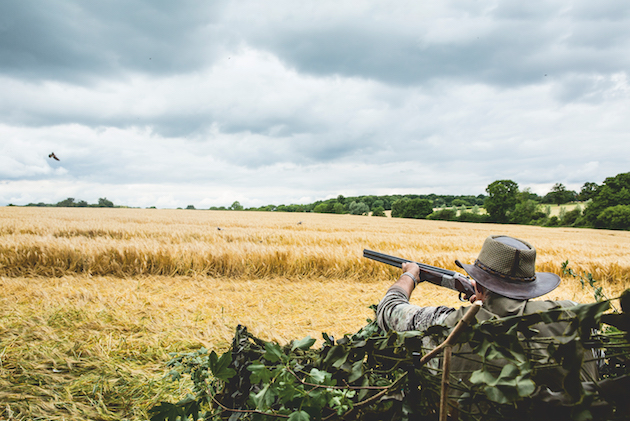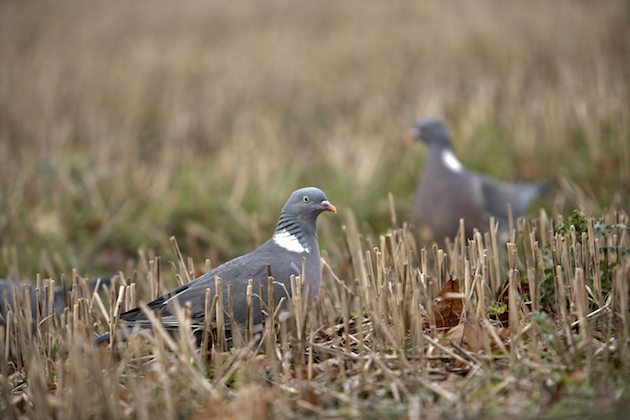Having a lot of pigeon shooting accessories isn’t for me. It might be what some pigeon shooters want but I’d…
Win CENS ProFlex DX5 earplugs worth £1,149 – enter here
Our experts test out four different calibres pigeon shooting
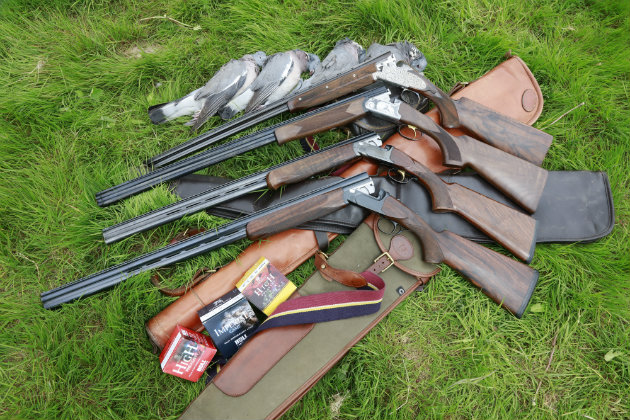
I usually go off shooting pigeons with a Perazzi MX12.
So when Patrick Galbraith called me with an idea of trying some different guns in different calibres for pigeon shooting I didn’t really jump at the opportunity.
My Perazzi MX12 has been custom-fitted for me. If the day goes well I feel it has been successful. If it doesn’t, well.
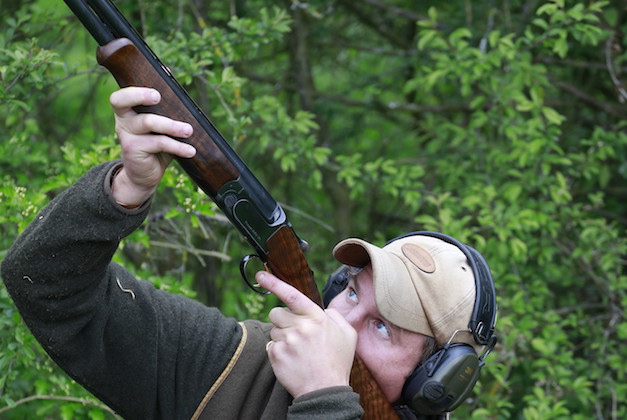
Tom tries out the Perazzi MX20
Shooting pigeons with a Perazzi MX20
Shooting smaller bores would be curious because of their size. Anything other than my Perazzi would feel strange. Part of the experiment called for me to try shooting pigeons with a Perazzi MX20.
Smaller bores and pricked birds
Most game shooters will have heard people say “they all kill the same”, or the standard “you either kill them or you miss”. I think that the second statement is ludicrous. It suggests that with smaller bores you don’t prick birds. This isn’t true and in fact when you use smaller bores at distance you are often unaware of pricked birds.
When we’re out shooting game we need to do our best to ensure clean kills. Of course birds do get pricked from time to time, but you have to try to reduce the chances of this happening. To do this you need to use a suitable gun and cartridge that will despatch the bird swiftly.
Using smaller bores can increase the risk of birds being wounded if you attempt to shoot them as though you are shooting with a 12-bore. You have to be sensible and very aware of your capabilities — and this will be most particularly determined by range. It’s not that a 40-yard crosser can’t be killed by a .410, but you do run the risk of pricking the bird, very much the same as taking on 70-yard crossers with a 12-bore. If you are going to shoot smaller bores then shoot responsibly.
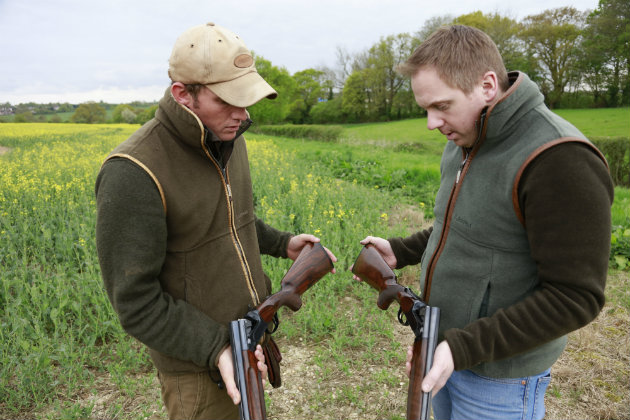
Tom and Carl discuss the different guns
Two’s company
I was lucky to be joined by Carl Russell, a fantastic gunsmith based in Hertfordshire. Carl is a good friend and also keen to try out pigeon shooting with the first gun on our list, the Browning .410.
These days most .410s have either been altered in some way for young Shots, or have been made with only young Shots in mind. Because of this, the majority of them are unshootable for the average adult because their stock measurement is too small and their weight is uncontrollable, with the result that you end up throwing it around like Harry Potter’s wand. But the Browning .410 has really good stock measurements — 15in to mid, a drop measurement that allows you to shoot properly and not play hockey with it, and a sensible cast measurement.
The barrels were 30in long and the weight was well balanced. Combined with a good Hull .410 game cartridge, Carl had every opportunity to shoot the best of ability, which he did. I can see the enjoyment that people have from shooting smaller bores but I do also think they can be used as an easy excuse for missing something (or make you look like a hero if you hit it). Carl was selective about what he felt was sensible to take on, but with a few birds really committing to the irresistible lure of dead bird decoys, he got some good old-school, classic pigeon shooting and despatched four or five pigeons.
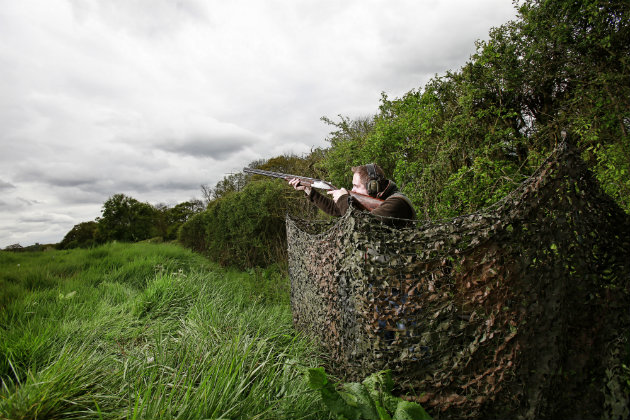
Tom found the shorter stocked shotguns too light for him
We were on a time limit though because we could see bad weather drawing in, so with the other three guns still to shoot we had to cut short Carl’s fun with the .410. Carl moved onto the 28-bore Cogswell & Harrison. He treated it similarly to the .410 — he was selective and birds continued to decoy well, but it was hard for him to shoot with it as it was small and light. He worked away, frustrated at times, and he did shoot five or six good birds, but it wasn’t easy. I think he was pleased to put it back in its slip.
I wasn’t man enough to shoot the smaller bores; I’m a wimp when it comes to the thought of missing a shot and chucking toothpicks about isn’t for me. Instead I started shooting pigeons with a Perazzi MX20 and my MX12.
Hanging woodpigeon – how to handle the birds after you’ve shot them
Hanging woodpigeon Eating woodpigeon you’ve shot yourself is wonderfully satisfying but keeping them in the best condition before cooking is…
The MX20 was short in the stock and the barrels were only 28in long; I struggled to control it and didn’t set the world on fire with it. With a bit of practice I could have been more effective, but not on this occasion. It was a well-balanced gun though with very crisp trigger pulls; but for me it was just too light. (That’s my excuse for a below-average performance, anyway.)
With my MX12 in hand normal form was resumed, though it nonetheless took a bit of time to readjust, which goes to show how chopping and changing guns means you will struggle to shoot with any consistency. I shot a dozen or so pigeons, and we had finished on 37 in total, before it was time to pack away. The dark clouds were looming and becoming more menacing by the second.
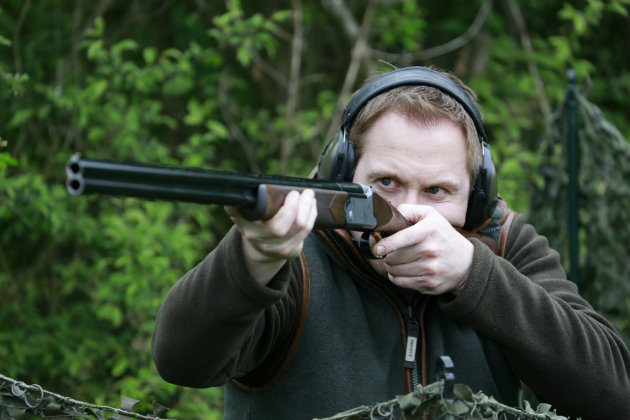
Carl takes aim with a 28-bore Cogswell & Harrison shotgun
How to find the right pigeon gun for you
You can’t run the 100m to the best of your ability if your running spikes don’t fit. Shooting is no different. Your gun has to fit correctly and the weight and balance has to be right.
What you shoot with is a personal choice but there are key factors to bear in mind:
- Is it well made and reliable? A good investment will be a gun that won’t let you down if you look after it well.
- Is it compatible with your size and strength? This will determine the bore of the gun and its weight.
- Does it fit? Style and technique aside, your gun must fit you properly so that you are able to shoot to the best of your ability.
- Is the barrel length right? Short barrels don’t give you as much control as longer barrels. I recommend 30in barrels across the board, from anyone starting out to those who shoot a reasonable amount.
- What choke? Ideal chokes are half and half or three-quarters and three-quarters, fixed. These are very good all-round game chokes.
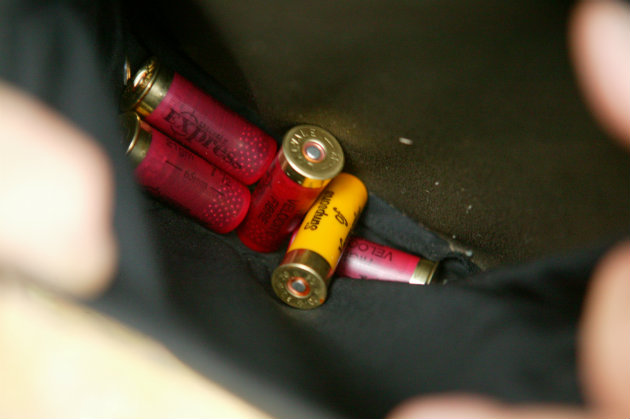
Never mix cartridges
A note on safety
When you are shooting with different calibres like this, it is vital that you keep all cartridges separate – put them in separate bags and double check them constantly so that there’s never any danger of a mix-up. Most dangerous is the combination of 12- and 20-bore cartridges (above).
This article was originally published in 2017 and has been updated.
Related Articles
Get the latest news delivered direct to your door
Subscribe to Shooting Times & Country
Discover the ultimate companion for field sports enthusiasts with Shooting Times & Country Magazine, the UK’s leading weekly publication that has been at the forefront of shooting culture since 1882. Subscribers gain access to expert tips, comprehensive gear reviews, seasonal advice and a vibrant community of like-minded shooters.
Save on shop price when you subscribe with weekly issues featuring in-depth articles on gundog training, exclusive member offers and access to the digital back issue library. A Shooting Times & Country subscription is more than a magazine, don’t just read about the countryside; immerse yourself in its most authoritative and engaging publication.






